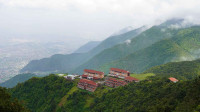Money
Five mountaineers to attempt extreme winter ascent of Everest
Two German and three Spanish climbers will try to scale the world's tallest peak without oxygen.
Sangam Prasain
Krzysztof Wielicki of Poland first climbed the world’s tallest peak in the dead of winter on February 17, 1980. Ang Rita Sherpa, known by the epithet of Snow Leopard, has climbed Everest 10 times without using supplemental oxygen, and one of his ascents was in the winter of 1987-88.
Everest has never been climbed in winter since 1993.
During the 2019 autumn climbing season which lasts from September-November, two planned attempts on Everest, the first after a decade, failed due to poor weather conditions.
Among the five aspirants, two Germans—Jost Kobusch and Hug Daniel—are currently acclimatising on the slopes of Everest, said Rishi Bhandari, managing director of Satori Adventures which is handling the group.
“On Monday, they moved down to base camp at 5,380 metres after reaching up to Camp II (6,400 metres) as part of their acclimatisation.” The German climbers are not using climbing aids like ropes or ladders.
According to Bhandari, the two Germans are exploring a new route, and they are climbing without oxygen. “The climbers will use the south-west ridge which has never been climbed in winter before,” he said, adding that it would be an extreme mission because of three factors—winter, without supplementary oxygen and an unfamiliar route.
In winter, the days are shorter and the nights longer with cold nights. “It’s difficult. If they fail to reach the summit, they will make further attempts in the following years,” said Bhandari.
The winter climbing permit lasts up to February-end. The government charges $2,500 per person for climbing Everest using other routes. During the spring and autumn, the other route costs $10,000 and $5,000 respectively.
The other team attempting a winter attempt consists of three Spanish climbers—Oscar Cardo Briones, Jonatan Garcia Villa and the leader Alex Txikon.
“They reached Namche Bazaar in the Khumbu region on Monday, and are scheduled to reach base camp on January 16. They will climb Ama Dablam (6,812 metres) first by January-end and launch the Everest mission after that,” said Mingma Sherpa, managing director of Seven Summit Treks.
The Spaniard Everest expedition will be handled by Outware Treks and Expedition. Sherpa said that the trio had targeted reaching the summit of Everest by February-end.
Pemba Sherpa, managing director of Outware Treks and Expedition, told the Post that three high-altitude Sherpa guides and an icefall doctor had been preparing the route at the Khumbu Icefall for the climbers. “They will not use oxygen but will take the normal route to reach the summit.”
According to him, this will be their third winter attempt after the failed missions in 2016 and 2017. In 2017, they reached up to Camp IV (8,000 metres) but had to return due to bad weather.
The last winter ascent, according to Tourism Department records, was made by Shinsuke Ezuka of Japan on December 20, 1993.
The department had issued permits to 10 climbers—four American, four Polish, one British and one Spanish—to make a bid to scale Everest in the autumn season. They had to drop their plans as the post-monsoon extended for nearly two weeks, causing disturbances in the weather pattern.
The world’s highest peak normally sees the highest number of climbers during the spring season. Very few have climbed it during the autumn and winter seasons.
In the 1980s, climbing in the autumn and winter was more popular than in the spring. After the advent of democracy in 1990 in Nepal, the government adopted a liberal economic policy in 1992 and Everest was also opened to everyone and during any season. As a result, climbers started to avoid the autumn and winter climbing seasons due to the risk and extreme cold.
Everest height measurement team currently processing data
Nepal's Department of Survey, which is measuring the height of Everest, said it would take another two months to complete the process. The department had planned to announce the height of Everest by January, to end the nearly two-centuries-long controversy and declare, once and for all, the altitude—both snow and rock height—of the world’s tallest mountain.
“We have completed all the measurements and surveys, and have been processing the data,” said Susheel Dangol, chief survey officer of the Everest Height Measurement Secretariat under the Department of Survey. “We expect to announce the definitive height of Everest after two months.”




 16.66°C Kathmandu
16.66°C Kathmandu















